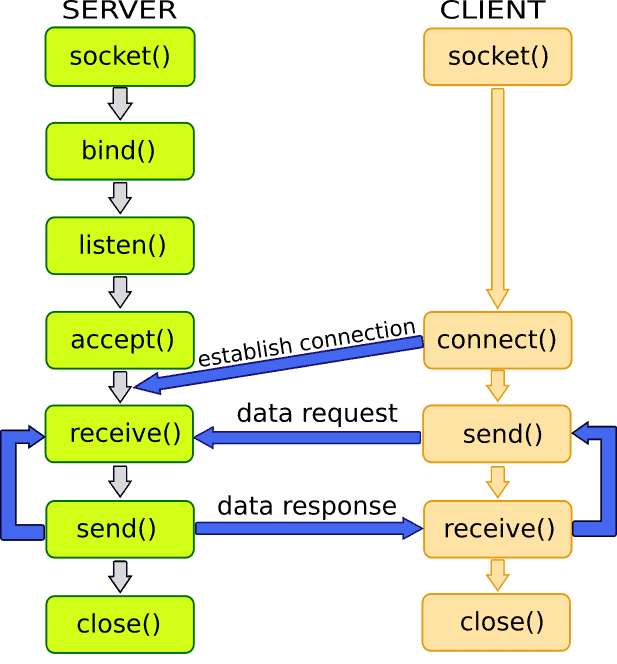1. 概述
在本篇文章中,我们将回顾网络编程中 socket 的基本概念,并重点介绍如何将 socket 绑定到任意一个系统可用端口上。
2. Socket 基础知识
Socket 是网络通信中两个节点之间连接和通信的端点。 它提供了双向的 FIFO 通信方式。通信双方都需要创建 socket,其中 socket 地址通常由 IP 地址和端口号组成。
在客户端-服务器架构中,服务器端首先创建一个 server socket,并绑定到一个特定端口上。客户端则创建自己的 socket,并尝试连接到服务器的 socket。一旦连接建立,数据传输就可以开始。
Socket 通常分为两类:
✅ 数据报 socket(Datagram Socket):基于 UDP,无连接通信,无需建立连接即可发送数据,类似于邮箱通信。
✅ 流式 socket(Stream Socket):基于 TCP,面向连接,通信前必须先建立连接,类似打电话。
服务器节点创建 TCP 或 UDP socket,监听特定 IP 和端口,等待客户端连接。客户端则通过指定的 IP、端口和协议发起连接。主流操作系统都支持 socket,其机制类似于文件系统的文件描述符。
3. Socket 编程基础
Socket 编程是创建和连接 socket 以实现网络数据传输的一种方式。 下面是一些常用 socket 函数及其作用:
| 函数名 | 描述 |
|---|---|
socket |
创建一个新的 socket 描述符 |
bind |
将 socket 绑定到本地地址或端口 |
listen |
表示 server socket 已准备好接收客户端连接 |
accept |
接受客户端连接请求 |
send |
向远程主机发送数据 |
recv |
从远程主机接收数据 |
close |
关闭连接 |
connect |
在 TCP 中连接远程服务器(需指定 IP 和端口) |
sendto |
在 UDP 中发送数据(无需连接) |
TCP 基于连接,流程如下图所示:

UDP 是无连接的,因此无需调用 connect(),流程如下:

4. bind 函数的作用
bind() 函数用于将 socket 绑定到本地端口,并保留该端口资源。它接受 socket 描述符作为输入,并返回绑定状态:
algorithm BindSocket(s_d):
// INPUT
// s_d = 一个 socket 描述符
// OUTPUT
// 绑定成功返回 true,否则 false
server_address <- "127.0.0.1"
port_number <- 8283
length <- sizeof(server_address)
status <- bind(s_d, server_address, port_number, length)
if status = true:
log(status)
else:
log(status)
return status
通常在调用 socket() 之后调用 bind(),以将 socket 描述符与本地端口绑定。该函数主要用于服务端,使得客户端可以通过指定端口连接服务器。bind 操作仅在本地机器生效,用于指定接收数据包的地址。
比如我们通常会绑定到 127.0.0.1:8323,但该函数在 TCP 和 UDP 中行为一致。
5. 绑定任意可用端口的方法
上面的例子中,我们绑定了一个硬编码的端口 8323。但如果该端口已被占用,绑定就会失败。 所以,在实际开发中,有时我们希望让操作系统自动分配一个可用端口。
5.1 使用端口 0 自动分配
调用 bind() 时,将端口号设为 0,即可让操作系统分配一个可用端口:
algorithm BindSocketMethod1(s_d):
// INPUT
// s_d = 一个 socket 描述符
// OUTPUT
// 绑定成功返回 true,否则 false
server_address <- "127.0.0.1"
port_number <- 0 // 自动分配可用端口
length <- sizeof(server_address)
status <- bind(s_d, server_address, port_number, length)
if status = true:
log(status)
else:
log(status)
return status
这是最常见也是最推荐的做法。例如在 Java 中创建 ServerSocket 时传入 0:
ServerSocket ss = new ServerSocket(0);
int assignedPort = ss.getLocalPort(); // 获取实际绑定的端口
5.2 手动随机选择一个可用端口
如果你不希望使用操作系统自动分配,也可以手动从一个可用端口列表中随机选择:
algorithm BindSocketMethod2(s_d):
// INPUT
// s_d = 一个 socket 描述符
// OUTPUT
// 绑定成功返回 true,否则 false
server_address <- "127.0.0.1"
ports <- a list of all the available ports
port <- random(port) // 从可用端口中随机选一个
length <- sizeof(server_address)
status <- bind(s_d, server_address, port_number, length)
if status = true:
log(status)
else:
log(status)
return status
这种方式更复杂,且需要维护可用端口池,实际中较少使用。
6. 小结与建议
- ✅ bind() 是 socket 编程中非常关键的一步,用于将 socket 与本地地址和端口绑定。
- ✅ 如果希望绑定任意可用端口,最简单的方式是将端口号设为 0,由操作系统自动分配。
- ✅ 获取绑定后的实际端口号(如 Java 中调用
getLocalPort())非常重要,尤其在分布式系统或测试环境中。 - ⚠️ 避免硬编码端口号,否则在端口被占用时会导致启动失败。
- ⚠️ 在测试中自动分配端口可以避免端口冲突问题,提升测试稳定性。
通过灵活使用 bind 函数,我们可以更有效地管理网络资源,避免端口冲突,提高程序的健壮性。